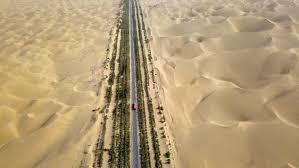By Han Liqun, Peoples Daily
In Taklimakan Desert, the largest desert in China and the world's second largest shifting sand
desert located in northwest Chinas Xinjiang Uygur Autonomous Region, lies a 522-kilometer
highway.
The Tarim Desert Highway was completed in September 1995. It starts from Minfeng county in
the middle of the southern edge of the Tarim Basin, and reduces the distance between the county
and Urumqi, capital of Xinjiang by over 1,000 kilometers, serving as a powerful driver for the
economic and social development of southern Xinjiang.
Over 20 years has passed and the highway is still reliable a driver surnamed Zhang who often
travels on the highway told Peoples Daily.
The buffer strips along both sides of the highway are not only pleasing to the eye, but also help
prevent desertification and fix the sand, Zhang said, adding that the highway is of huge
significance.
To build a highway on a shifting sand desert is never an easy task.
Back in March 1990, a scientific exploration team of 32 experts in desert, hydrological and
engineering studies arrived in the desert for route selection.
They arrived at a season when the Taklimakan Desert was swept by strong winds. The sands
blown up in the air slapped on their faces and arms, and even into their eyes, mouths, ears and
noses. After traveling 3,800 survey points and analyzing 110 sand and soil samples, they finally
completed the route selection and scientific exploration.
In October 1991, the engineering studies of the highway was officially listed as a key national
programs for science and technology development for the 1991-1995 period. It achieved many
breakthroughs that filled the blanks in desert highway engineering and resource and environment
studies.
Highway maintenance is an even harder task, especially in the Taklimakan Desert.
"The road is often buried by sands when the wind comes, so how to fix the sand is a challenge,"
said Xu Xinwen, a researcher at the Xinjiang Institute of Ecology and Geography, Chinese
Academy of Sciences, as well as the director of the National Engineering Technology Research
Center for Desert-Oasis Ecological Construction.
To achieve long-term protection and sound operation of the highway, experts boldly proposed to
build a shelter forest along the desert highway. Xu participated in the forest construction all along.
In 1994, a pilot experiment on building shelter forest was carried out by scientists and technicians,
who successfully found a way to plant and irrigate trees with the highly mineralized underground
water.
They completed a 6.3-kilometer trial project for desertification prevention five years later and then
built a 30.8-kilometer ecological demonstration shelter forest in 2001.
A total of 88 plant species out of the 173 in northwest China that are drought-enduring and resist
salt and alkali were selected and planted by scientists in an experimental zone over the past 10
years.
The construction of the shelter forest commenced in 2003 with a total investment of 220 million
yuan, and was completed two years later. It stretches 436 kilometers along the highway with a
width ranging from 72 to 78 meters.
A total of 114 wells have been drilled along the forest belt, and 22,000 kilometers of water supply
pipelines were laid. Over 80 percent of the 20,000 saplings planted survived.
With the water supply pipelines, the shelter forest project fully made use of the underground water
and employed decentralized water supply and drip irrigation, Xu pointed out.The total annual
water consumption of the project is no more than 6 million cubic meters, and the water
consumption per hectare no more than 2,000 cubic meters.
Meanwhile the basic reserve of groundwater along the highway is 1.629 billion cubic meters, and
the annual recharge around 90 million cubic meters. It means that the extraction of groundwater
will not deteriorate the ecology of the desert, Xu explained.
With the construction of the shelter forest, the ecology there became diversified. More and more
yarkand hares, a rabbit species specific to the region, are observed, and rats, foxes and eagles are
also coming to the desert, Xu noted.
The highway improved the living environment and facilitated transportation for local people, and
the buffer strips along the highway also set a green wall against desertification. The highway is
making the vast sea of sands less desolate.












